In this article:
- Advantages of RCS branded messages
-
9 easy steps to create your branded message strategy
- 1. Set your strategic objectives
- 2. Choose your RCS use case (push vs conversational)
- 3. Segment your audience
- 4. Craft messaging guidelines
- 5. Design your RCS branded message experience
- 6. Aim for as much personalization as possible
- 7. Know your compliance and privacy responsibilities
- 8. Launch, measure, and optimize!
- 9. Integrate RCS into your omnichannel branded message strategy
- Start sending RCS branded messages
Have you ever wondered how your messages to customers could feel like more than just words on their screens? These could be interactive messages that show videos or maps, or even carousels that let customers swipe through images – all sent from a branded company profile. That’s exactly what Rich Communication Services (RCS) messaging offers, and it’s changing the way customers interact with brands.
As RCS gains traction, especially with Apple’s upcoming support this year, brands are jumping on board. In this article, we’ll explore why RCS can help build trust in your brand, and then we’ll offer actionable steps from mobile messaging experts about how to create an effective RCS branded messages strategy that improves ROI, drives traffic, and more!
Advantages of RCS branded messages
Let’s start with a few of the ways that branded messages signal trust to customers and can help boost engagement.
Verified sender authentication
Embedded within the RCS Business Messaging protocol, verified senders visually confirm a business’s authorization to use its name and logo as part of the conversation. Becoming a verified sender is crucial to RCS, as it signals a stamp of approval from a specialized entity like Mobile Network Operators (MNOs) and reassures customers that messages are legitimate.
After a business has been verified, recipients will see a series of visual cues like the official brand name, colors, and a unique checkmark right at the top of the conversation.
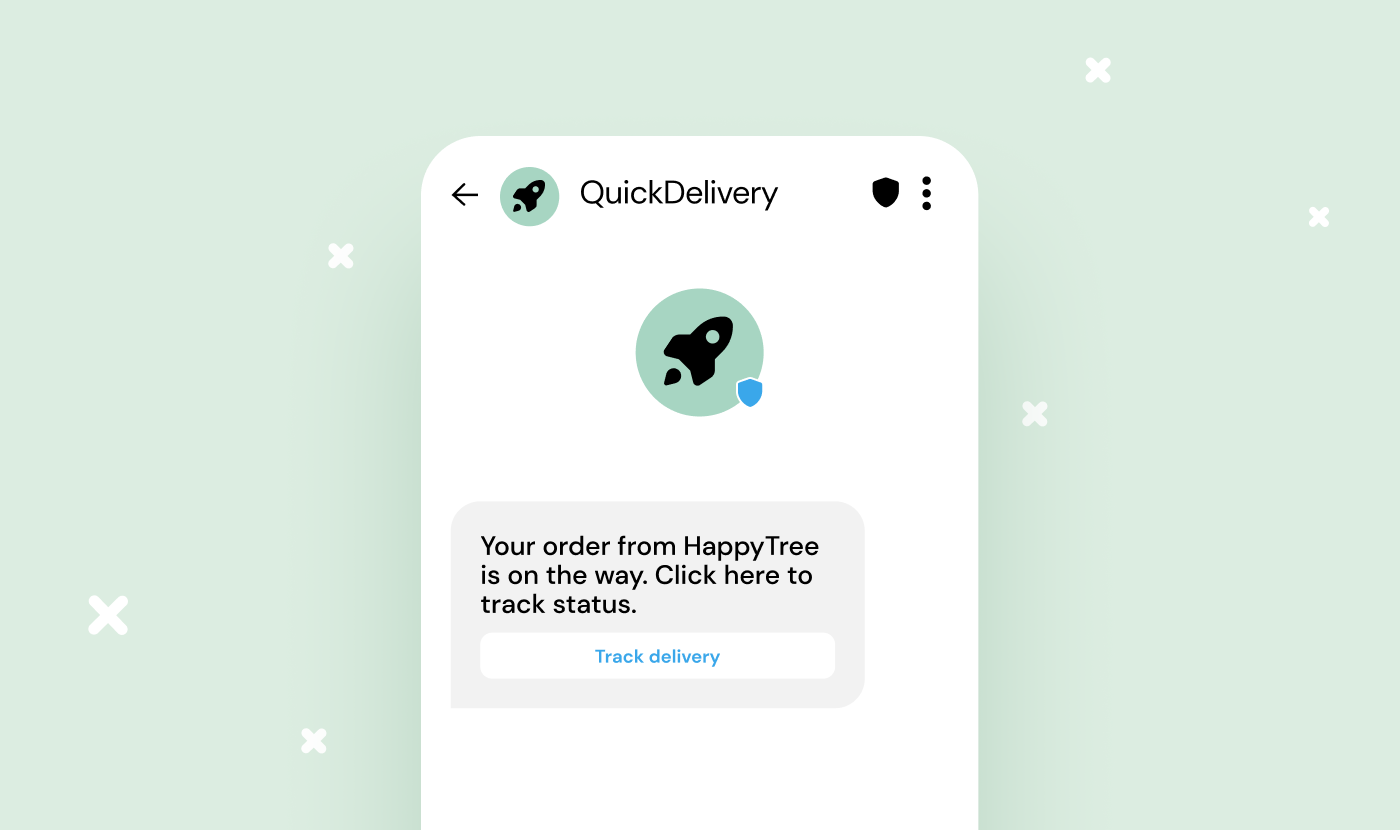
Once a brand has a verified sender profile in RCS, recipients instantly know they’re chatting with a legitimate business.
Better brand visibility
Have you ever texted a business and been left wondering if they received your message? Or maybe you’ve received a text from an unfamiliar number, unsure if it was from a business you know?
With RCS Business Messaging, these uncertainties are a thing of the past. Branded messages mean businesses can display their brand identity directly within the messaging interface. That means there’s no more guesswork – subscribers can instantly recognize who a message is coming from and become more familiar with your brand.
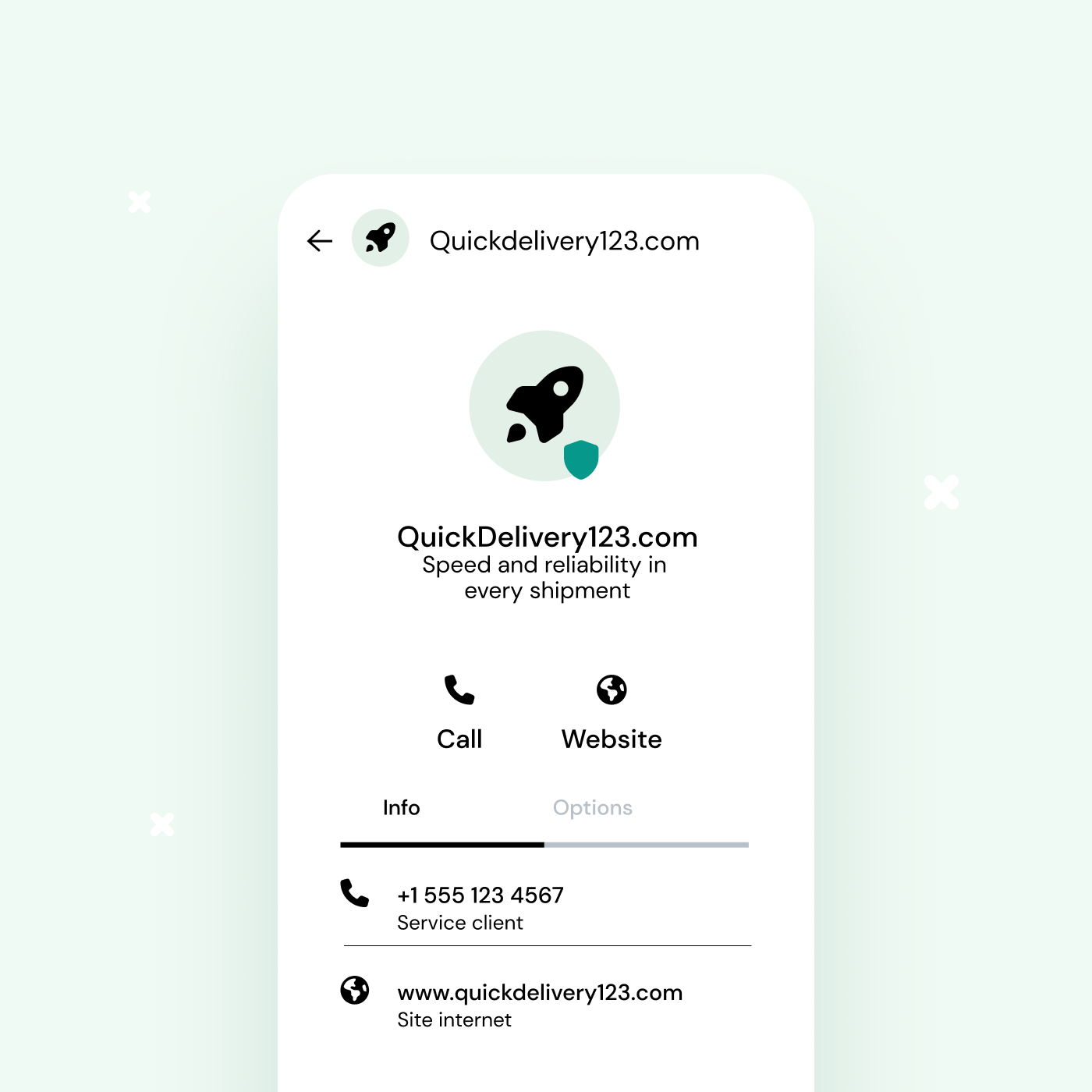
Branded profiles in RCS mean recipients have access to a brand’s email address, website, and phone number directly in every interaction.
Another plus? It’s harder to leave a message on read when businesses are sending visually engaging, personalized carousels and product images that practically demand attention.
Interactive, rich media
RCS is designed for engagement, plain and simple. How so? Well, RCS business messages allow brands to offer exciting content like product carousels, maps images, GIFs, and more, directly within messages themselves. Plus, it enables easy payments right in the messaging app, so users can buy plane tickets or use loyalty cards that are directly linked to their digital wallet.
These features aren’t just for show – they help build trust! That’s because by sending content that subscribers actually want to see, businesses can show they’re worth their time and attention.
9 easy steps to create your branded message strategy
Are you intrigued? RCS will establish branded, trusted messaging as the new standard, and soon, it’s what your customers will expect.
When you’re ready to send RCS messages, setting up a sender agent is surprisingly easy when you have the right provider. Then, when you’re ready to plan your campaign, we’ve developed a step-by-step guide to help you craft successful RCS branded messages that can have a considerable impact on ROI, engagement, and sales.
1. Set your strategic objectives
First things first: You need to clarify your brand’s objectives. What does your brand want to accomplish with RCS? Is it boosting customer engagement, driving sales, or perhaps both? Being specific and ensuring these objectives are measurable sets a clear path for what comes next.
Here are a few strategic RCS objectives that we’ve seen brands have success with:
-
Drive website traffic
-
Promote a newly launched app
-
Improve ROI
-
Increase sales by sending personalized offers
-
Streamline the purchase process
-
Digitize product catalogs
-
Reduce churn
-
Reach all clients easily
-
Implement an omnichannel communication strategy
2. Choose your RCS use case (push vs conversational)
Based on your business’ objectives, you can then choose to send push (one-way) or conversational (two-way) RCS messages.
Here’s what we mean by that: If your goals are around gaining visibility, like promoting your app or driving traffic to your website, or if they’re around sales objectives, opt for push messages which offer one-way updates to your subscribers. By sending these messages via RCS, you can send interactive messages that achieve higher open rates as compared to other messaging channels. Plus, push RCS messages allow for you to include one to four calls-to-action (CTAs) – for example, you could redirect people to a webstore, physical store, or call center, depending on their buying habits.
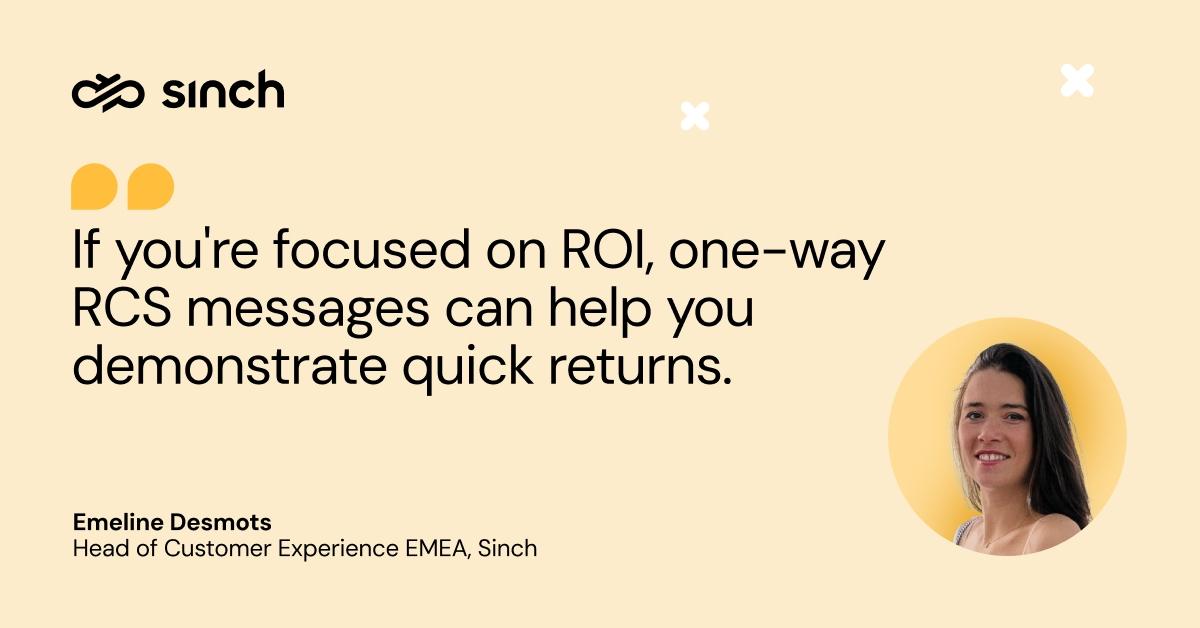
“If you're focused on ROI, one-way RCS messages can help you demonstrate quick returns so that you can move into conversational messaging,” says Emeline Desmots, Head of Customer Experience EMEA at Sinch.
If your goals are more focused on building relationships and gathering insights from your audience, such as reducing churn, collecting data, or generating qualified leads, you should use conversational RCS messages, which offer two-way messaging capabilities.
3. Segment your audience
You wouldn’t chat with a college student in the same way that you would with a retiree, right? Just like you change your tone in individual conversations, your target audience has diverse priorities and interests that need catering to. Segmenting based on age, location, shopping habits, or other demographics can help your messages resonate.
Our advice: Start with a test. RCS is new for some, so gauge reactions to the channel with a small group first.
“Many brands we work with have found that their 35–55-year-old clients engage most with RCS messages. Test your messages across audience segments; younger demographics may respond differently to promotions than older ones.” - Emeline Desmots, Head of Customer Experience EMEA, Sinch
Every brand is unique, so run tests to discover what works best for yours.
4. Craft messaging guidelines
One of the game-changing aspects of RCS messaging is that your brand’s visual identity will be baked into every message. But it's only one step to show people your brand – you need to tell it to them as well. This is where a consistent brand voice, tone, and messaging play a key role.
You’ll want to define a few things as you put together your strategy:
-
Your brand voice: This is the personality that shines through in each of your communications, reflecting who you are as a brand.
-
Tone: This is the way you convey your message, adapting to suit different contexts and audiences.
-
Key messaging points: These are your brand’s core values, offerings, and selling points, together defining what your brand stands for.
With these elements in place, you can ensure every branded RCS message both shows and tells your brand’s identity and value proposition.
5. Design your RCS branded message experience
Now that you've solidified your strategic objectives, identified your audience, and set clear messaging guidelines, it’s time to focus on how your first RCS messages will look and feel.
Keep your messages short and to the point. Clearly communicate the purpose behind the conversation and avoid overwhelming your audience with complex or lengthy content. We recommend keeping your initial messages short and sweet, with only 2-3 steps or questions. This encourages subscribers to want to stay engaged the next time you reach out to them.
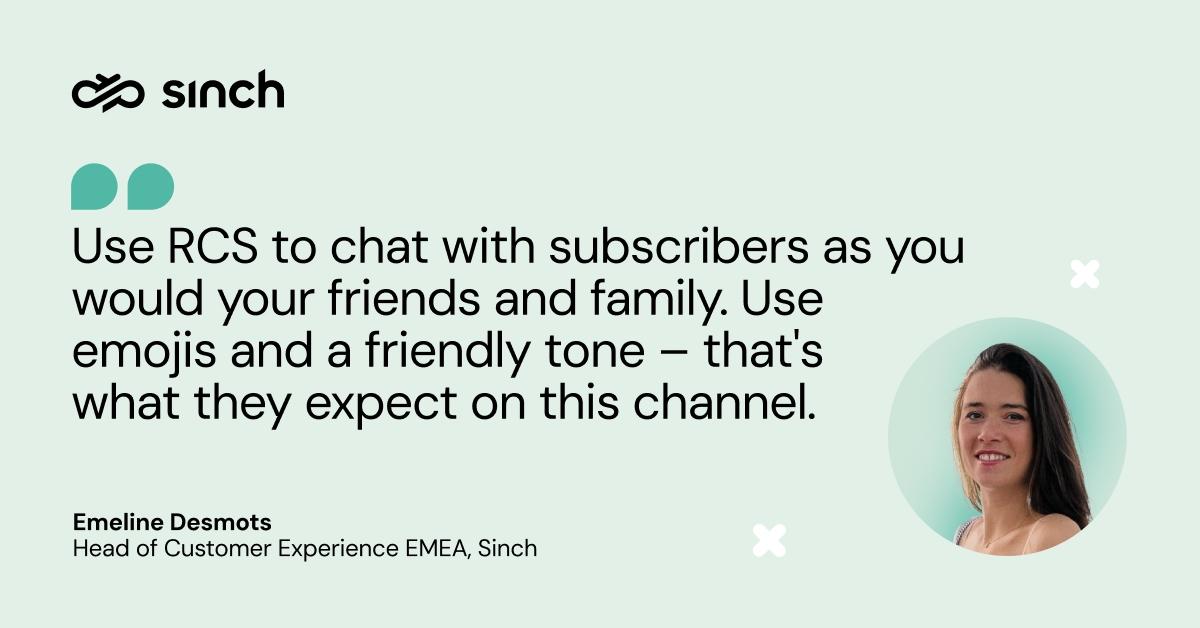
“RCS allows you to chat with subscribers in an app they’re used to talking to their relatives on. Chat with them as you would your friends and family. Use emojis and a friendly tone – that's what they expect on this channel,” says Emeline Desmots, Head of Customer Experience EMEA at Sinch.
After you’ve sent your initial messages, you should learn from them to build on the conversation. This makes the conversation more natural and in-line with what your recipients want to discuss.
Additionally, make sure your message flow feels like a real conversation. Use buttons and carousels, but also give subscribers the chance to reply in their own words.
“When you’re designing your experience, don’t rely too much on buttons and carousels – they can be distracting, or take a long time to load. You should let clients respond naturally to maintain the conversation.” - Emeline Desmots, Head of Customer Experience EMEA, Sinch
Just remember: Your communication strategy should always reflect your objectives!
6. Aim for as much personalization as possible
RCS is inherently interactive, making it perfect for personalized messaging. Tailor messages to what you know about your audience – their name, their product preferences, their location... the world is your oyster!
For instance, you can use personalized images on the first standalone card in an RCS carousel, and show products relevant to the subscribers’ gender, location, or interests. Adding the subscriber’s first name in the introduction also adds a personal touch.
Brands can also use RCS messages for cross-selling and upselling tactics.
“You can reference the subscriber’s past purchases and recommend related or complementary products. You can also provide personalized recommendations and links to their shopping cart after they’ve shared their budget, preferences, or interests.” - Emeline Desmots, Head of Customer Experience EMEA, Sinch
Want an example? This is exactly what Picard did to create an engaging holiday strategy.
They used RCS to help their customers imagine their holiday menus, taking into account things like dietary preferences, budget considerations, and even their desire to cook.
Picard’s personalized campaign made every recipient feel like they were getting 1x1 service.
Personalized messages will help your messages resonate with your audience, making them feel valued and increasing their engagement with your messages.
Bonus: Check out these five examples of how retailers are using RCS messaging for abandoned cart messages and more!
7. Know your compliance and privacy responsibilities
Before setting up your RCS sender identity, you’ll need to provide proof that your subscribers will be able to opt in and out of your communications. In this way, opt-in is baked into the process.
If you’re already sending SMS through a provider like Sinch, consent for RCS messages typically suffices, but you’ll still need to vet your provider’s approach to handling, storing, and protecting user data in the target market. Make sure that these practices align with your business’ standards and comply with relevant regulations.
8. Launch, measure, and optimize!
After you’ve launched your campaign, you’ll need to test and iterate.
Make sure you’re measuring how your campaign measures up against your objectives and benchmarks – this can be through KPIs like conversion rate, click rate, read rate, or increases in engagement.
You can also A/B test RCS against other channels like Rich SMS, SMS, or email to see how your audience responds.
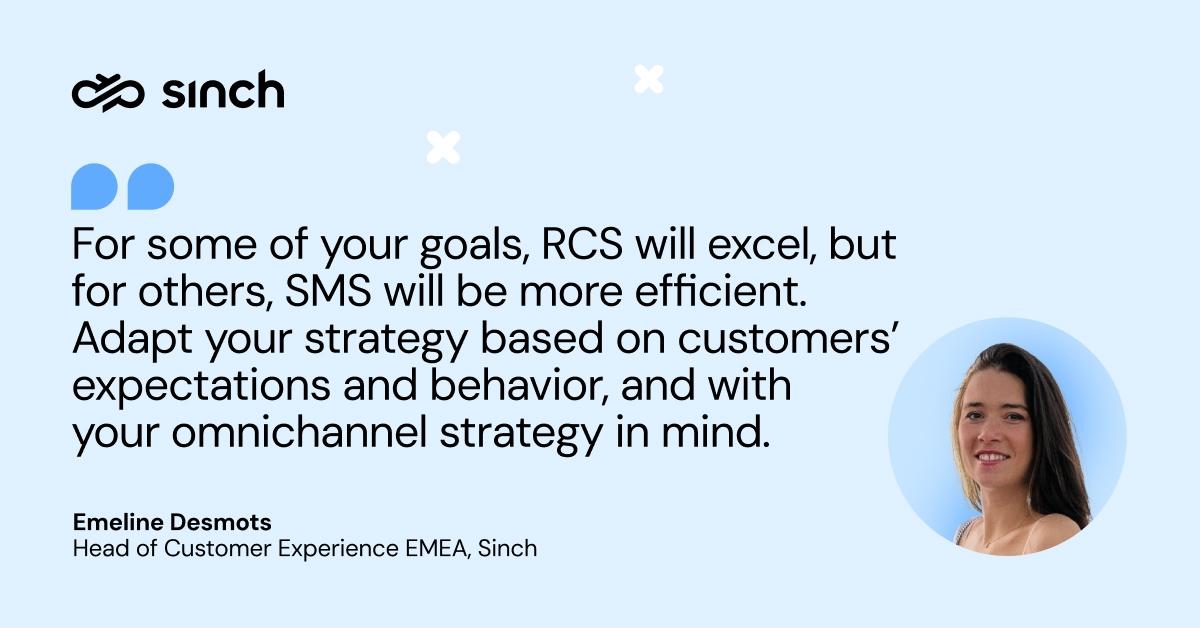
“Remember that RCS can be complementary – you can use it alongside other channels. For some of your goals, RCS will excel, but for others, SMS will be more efficient. Adapt your strategy based on your customers’ expectations and behavior, keeping your broader customer experience and omnichannel strategy in mind,” says Emeline Desmots, Head of Customer Experience EMEA at Sinch.
9. Integrate RCS into your omnichannel branded message strategy
Now that we’ve explored RCS's potential, it’s clear that it can be a powerful tool for building trust and boosting engagement. But remember, even with Apple’s move towards adopting RCS, you can’t afford to disregard other channels. And that’s exactly where an omnichannel strategy can help your brand shine.
All Over-The-Top (OTT) channels have some sort of branded sender functionality – so our advice is to keep your messaging and imagery consistent across channels to strengthen your brand identity.
“When a client signs up to your loyalty program, you expect them to check their email inbox to check for the first message. But it’s tough to prompt purchases through emails. RCS offers a solution by delivering a unique experience directly to your clients’ messaging apps, which could include personalized product offerings.” - Emeline Desmots, Head of Customer Experience EMEA, Sinch
Choosing RCS isn’t about replacing other channels – it's about using it strategically, so your messages have maximum impact.
And when you choose to send RCS messages through a provider like Sinch which offers a single API as access to multiple messaging channels, you can ensure all messages are delivered based on your audience’s preferred channel, coverage availability, or handset capability.
Start sending RCS branded messages
RCS business messages offer brands a whole new way to engage with customers like never before. With one-way or two-way RCS, and with branded messages, you’re setting the stage for building trusted relationships with your customers, and future success!
Ready to master your RCS strategy? Download our comprehensive RCS guide, designed to assist you to advocate for bringing RCS into your organization.
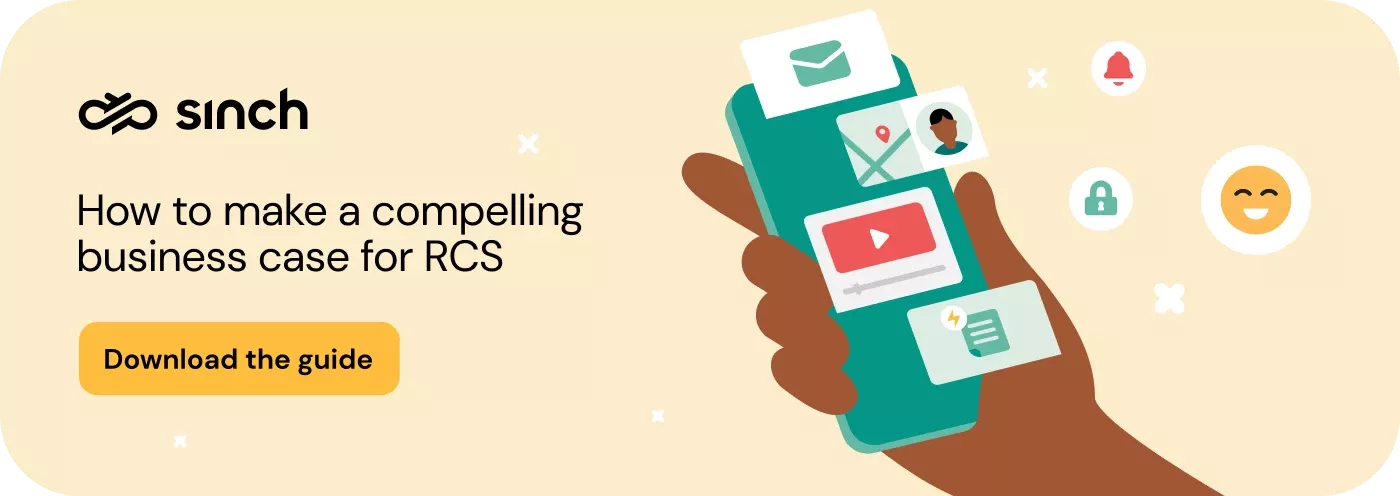
Or, if you’re looking for other inspiring RCS content, check out our RCS messaging resource hub for valuable insights on crafting rich messaging experiences that your customers will love.



